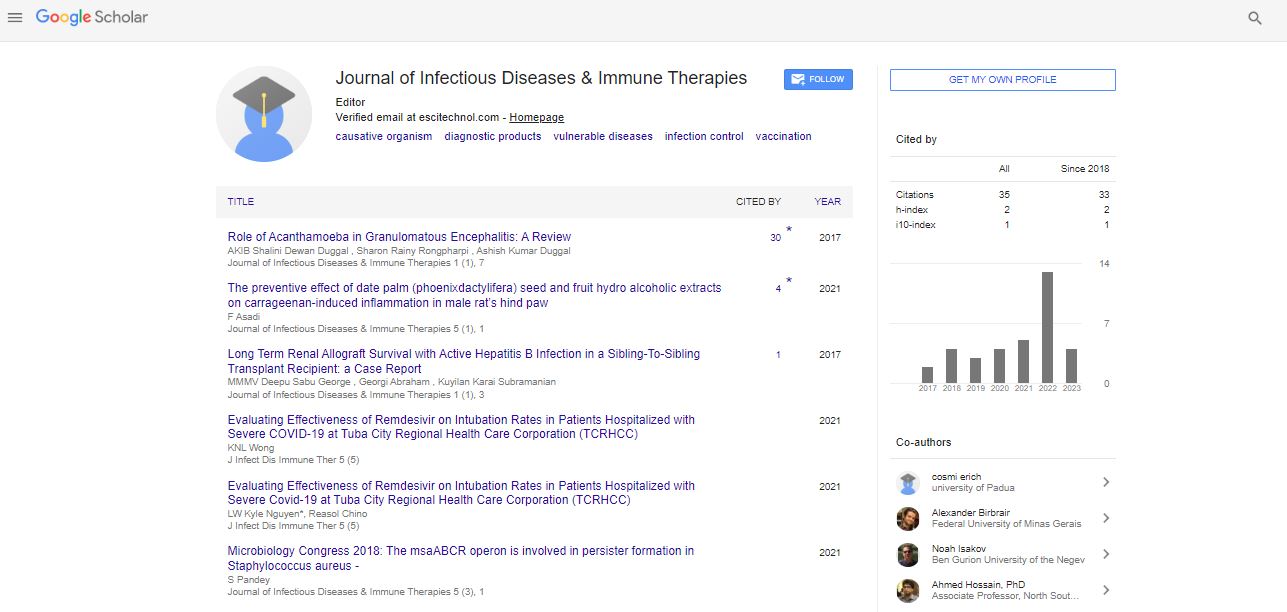Perspective, J Infect Dis Immune Ther Vol: 7 Issue: 1
Preventing Infections through Safe Injection Practices
Pereira Zaman*
Department of omen's and Children's Health Sciences and Public Health, Agostino Gemelli University Hospital Foundation IRCCS, Rome, Italy
*Corresponding Author: Pereira Zaman
Department of omen's and Children's Health Sciences and Public Health, Agostino Gemelli University Hospital Foundation IRCCS, Rome, Italy
E-mail: zampereira@irccs.it
Received date: 03 February, 2023, Manuscript No. JIDITH-23-93627;
Editor assigned date: 07 February, 2023, PreQC No. JIDITH-23-93627 (PQ);
Reviewed date: 21 February, 2023, QC No. JIDITH-23-93627;
Revised date: 28 February, 2023, Manuscript No. JIDITH-23-93627 (R);
Published date: 07 March, 2023, DOI: 10.4172/JIDITH.1000150
Citation: Zaman P (2023) Preventing Infections through Safe Injection Practices. J Infect Dis Immune Ther 7:1.
Description
Injections are one of the most common medical procedures worldwide. They are administered to millions of people every day to prevent, treat or diagnose a range of medical conditions. However, unsafe injection practices can transmit pathogens, leading to infections that can be serious and sometimes life-threatening. Therefore, it is essential to implement safe injection practices to prevent the spread of infection.
Importance of safe injection practices
Unsafe injection practices can lead to the transmission of a range of pathogens, including viruses, bacteria, and fungi. Blood-borne infections, such as HIV, hepatitis B, and hepatitis C, are among the most serious consequences of unsafe injection practices. However, other infections such as sepsis, abscesses, and cellulitis can also occur. These infections can be prevented by following safe injection practices.
Components of safe injection practices
Safe injection practices involve a combination of measures that reduce the risk of infection transmission. These measures include:
Proper hand hygiene: Hand hygiene is the most important component of safe injection practices. It is essential to clean hands before and after each injection. This can be achieved by washing hands with soap and water or using an alcohol-based hand rub.
Use of sterile equipment: The use of sterile equipment is necessary to prevent the transmission of pathogens. Sterile syringes, needles, and other injection equipment must be used for each injection.
Avoiding contamination of injection equipment: Injection equipment must not be contaminated by any means. This includes avoiding touching the needle or syringe after sterilization and not reusing disposable equipment.
Safe disposal of injection equipment: Injection equipment must be disposed of properly to avoid the risk of injury and infection. This involves using puncture-resistant containers and following local guidelines for disposal.
Educating healthcare workers and patients: Educating healthcare workers and patients is crucial to ensure safe injection practices are followed. Healthcare workers must be trained in safe injection practices, and patients must be informed about the importance of safe injection practices.
Preventing infections through safe injection practices
Preventing infections through safe injection practices requires a comprehensive approach that includes education, training, and strict adherence to guidelines. Healthcare facilities must provide their staff with regular training and education on safe injection practices. This training should cover topics such as hand hygiene, use of sterile equipment, and proper disposal of injection equipment. In addition, healthcare facilities must have strict policies and procedures in place for safe injection practices and ensure that they are followed by all staff.
Patients also plays an important role in preventing infections through safe injection practices. Patients must be informed about the importance of safe injection practices and should be encouraged to ask questions about the safety of injections they receive. They should also be aware of the signs and symptoms of infection and should report any concerns to their healthcare provider.
Conclusion
Unsafe injection practices can lead to the transmission of a range of pathogens and can have serious consequences. Safe injection practices are essential to prevent the spread of infection and must be implemented in all healthcare settings. This requires a comprehensive approach that includes education, training, and strict adherence to guidelines. By following safe injection practices, we can ensure that injections are safe and effective in preventing, treating, and diagnosing medical conditions.
 Spanish
Spanish  Chinese
Chinese  Russian
Russian  German
German  French
French  Japanese
Japanese  Portuguese
Portuguese  Hindi
Hindi 